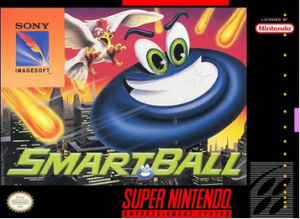
Author: John Legendoffzelda
In the game Smart Ball, the player controls a nameless blue thing: a viscous blob with big eyes and a small mouth that looks like a moving drop of water. This guy has no name because the English translation removed every trace of the original story for whatever reason, and on top of that it hid the content under a zippy box art and a title that could have been copied from a Nerf product. The video game action designed here by Sony Imagesoft and Game Freak (in those odd years before Pokémon) may be bereft of any context, but it’s actually more kid-friendly and straightforward than the English marketers would imply; it’s one more game about a cute creature that bops other cute creatures, and it doesn’t have any more edge than other games of its type. Given these facts, this game is difficult to hate, but details aside from the aesthetic make it equally difficult to like. Everything here just pans out into an unremarkable experience.
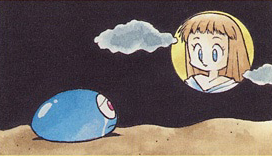 The little blue guy here is named Jerry, and according to the deleted story he was once a human boy. His jealous brother, Tom, recruited an evil wizard to turn him into a mound of jelly because both of them love the princess Emi. Tom is the sort of brother who would willingly overthrow his sibling if it meant one less person to interfere with his desires. With his new form, Jerry can climb along walls, scurry through narrow pipes, and stretch his body in a manner of directions. He must use these abilities to clear each of the levels. He can only cling to walls while in his dash mode, a mode that also makes him glow a brighter shade of blue. And he can’t turn certain corners on ceilings without falling down, yet the platforming business is designed rather conveniently around these limitations; each level is a short showcase of going up walls and crawling over the ground, and all they ask of the player is to deal with the roster of cute creatures that stand in his way. Considering these adorable things are the game’s enemies, they’re quite harmless since Jerry can defeat them by squatting on them, poking them with his stretched body or hitting them with red balls he collects from budding flowers. Sometimes the player can even just stand on the enemies’ head, which actually is requisite in more than one instance. And those balls not only act as projectiles but they can also replenish health and in addition, they can re-spawn inside those flowers until Jerry reaches his limit.
The little blue guy here is named Jerry, and according to the deleted story he was once a human boy. His jealous brother, Tom, recruited an evil wizard to turn him into a mound of jelly because both of them love the princess Emi. Tom is the sort of brother who would willingly overthrow his sibling if it meant one less person to interfere with his desires. With his new form, Jerry can climb along walls, scurry through narrow pipes, and stretch his body in a manner of directions. He must use these abilities to clear each of the levels. He can only cling to walls while in his dash mode, a mode that also makes him glow a brighter shade of blue. And he can’t turn certain corners on ceilings without falling down, yet the platforming business is designed rather conveniently around these limitations; each level is a short showcase of going up walls and crawling over the ground, and all they ask of the player is to deal with the roster of cute creatures that stand in his way. Considering these adorable things are the game’s enemies, they’re quite harmless since Jerry can defeat them by squatting on them, poking them with his stretched body or hitting them with red balls he collects from budding flowers. Sometimes the player can even just stand on the enemies’ head, which actually is requisite in more than one instance. And those balls not only act as projectiles but they can also replenish health and in addition, they can re-spawn inside those flowers until Jerry reaches his limit.
Even for a game of this type, the ease with which these actions can be done is peculiarly 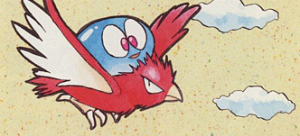 off-putting. Player-benefiting features like these are strong points, yes; except that’s because when they’re used in other games they encourage the player to overcome a challenge. Given what light gameplay content each level contains in general, the features here are less about teaching how to master a challenge than about teaching patience.
off-putting. Player-benefiting features like these are strong points, yes; except that’s because when they’re used in other games they encourage the player to overcome a challenge. Given what light gameplay content each level contains in general, the features here are less about teaching how to master a challenge than about teaching patience.
It’s easy to tell that this game is oriented towards young kids, although what exact age the developers are going for isn’t too definite. The levels are considerably short, and apart from the wall-crawling and enemy-hitting, the only thing they give the player to do is collect banners that spell out Jerry’s name. Each banner acts as a checkpoint, and collecting all five of them means bonus points. This skewing towards kids doesn’t end with the level designs, either. The game as a whole feels like a second-rate TV cartoon, something that would maybe air in that time frame when kids come home from school. It has a chirpy, cartoony soundtrack and a color scheme so thick with pastels and dyes it makes the barren desert look like ice cream; but more than that it has a poor cartoon’s logical inconsistency. In one uninterrupted string of events, Jerry goes to the desert, then he takes a rocketship to the moon, and then he falls into the ocean. Not even the level select menu makes sense: it’s a filmstrip where each level is a frame of film, and it doesn’t suggest anything but a leftover idea from something else. Perhaps this storytelling structure is meant to imitate a child’s stream-of-consciousness imagination, and if that’s the case then it creates a divide in the audience; younger players may accept this convention with no problem, but older ones will just find the narrative thrown together. The story really shouldn’t have been removed.
If younger kids are meant as the audience for this ricocheting character action and simple gameplay, then they aren’t going to appreciate the game’s underlying challenge. All the mice and fish  and balls of flame that stand in Jerry’s way may be easy to defeat, and the game seems to know that – so it has them re-spawn from off-screen and sometimes places them in precarious situations. The player might encounter an enemy that they can’t poke because it’s placed on a slope, and in response they decide to throw a ball. If they don’t have any, then they’ll have to either look for a flower or take a chance and try to jump over them. Jumping will likely be the biggest cause of lost hit points in this game: it’s all due to Jerry’s square jump arc, a squashed parabola of motion that often times means he’ll sail too far in a certain direction and by that same principle fall short of the platform he must cross. He can fly right into an enemy’s hit box or fall into a pool of lava, but he can’t leap high enough to reach the above platform without a running start – and that same running start is why he might go past or slip off of that one floating block that’s narrower than he is. The platforming requires too much precision from the faulty jumping mechanic, and both are out of place in the otherwise languid gameplay. Still, these problems aren’t enough to overwhelm the rest of the action, and with sixteen levels of it, the player just kind of accepts
and balls of flame that stand in Jerry’s way may be easy to defeat, and the game seems to know that – so it has them re-spawn from off-screen and sometimes places them in precarious situations. The player might encounter an enemy that they can’t poke because it’s placed on a slope, and in response they decide to throw a ball. If they don’t have any, then they’ll have to either look for a flower or take a chance and try to jump over them. Jumping will likely be the biggest cause of lost hit points in this game: it’s all due to Jerry’s square jump arc, a squashed parabola of motion that often times means he’ll sail too far in a certain direction and by that same principle fall short of the platform he must cross. He can fly right into an enemy’s hit box or fall into a pool of lava, but he can’t leap high enough to reach the above platform without a running start – and that same running start is why he might go past or slip off of that one floating block that’s narrower than he is. The platforming requires too much precision from the faulty jumping mechanic, and both are out of place in the otherwise languid gameplay. Still, these problems aren’t enough to overwhelm the rest of the action, and with sixteen levels of it, the player just kind of accepts them. The game is mostly about a blob of jelly that throws balls at cute things, so it isn’t like those problems are really harming anything because they’re there.
them. The game is mostly about a blob of jelly that throws balls at cute things, so it isn’t like those problems are really harming anything because they’re there.
That’s the sort of game that Smart Ball is: it’s there. It’s appealing and generally easy enough that little kids can pick up and enjoy, but the absence of any story or even character names prevents any investment that American kids can put into it. As it stands, the game is an anonymous, middle-of-the-road cartoon with decent visuals and a concept that’s nothing special. Maybe those marketers misrepresented this game on purpose because they were afraid it would underperform if it were sold on its own middling terms.
Three out of five stars.
CLICK HERE TO DISCUSS IN FORUM
HAVE AN OPINION?
You can submit reviews for games on the Submissions page.






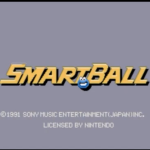

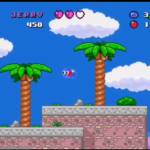
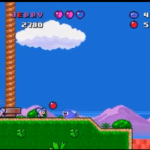
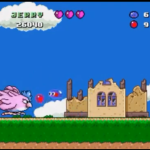
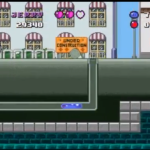

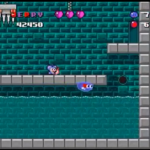


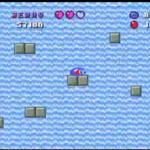
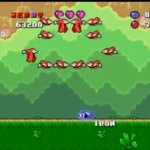
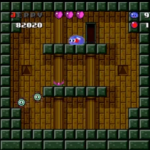



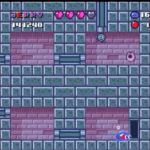
Technically the story wasn’t COMPLETELY cut but relegated to the manual (though Sony did the same thing was Equinox: they removed a scrolling text intro that was in the Japanese version, despite that Equinox was developed in both Japanese and English at the same time, and content coexists in both ROMs).
Though cute and cartoony was always Game Freak’s style.
Datam Polystar is the other company I can immediately think of as a “cute” games publisher, but their first was the decidedly-not-cute Musya. 😀
(though it looks like they moved on to love-simulation games in the 32-bit era 🙁 )
Dang manuals. I can never get a hold of them, and they always have information that could make a difference.
Try this guy: http://stores.ebay.com/The-Retro-Game-Center
He has a decent selection of manuals for fair prices.